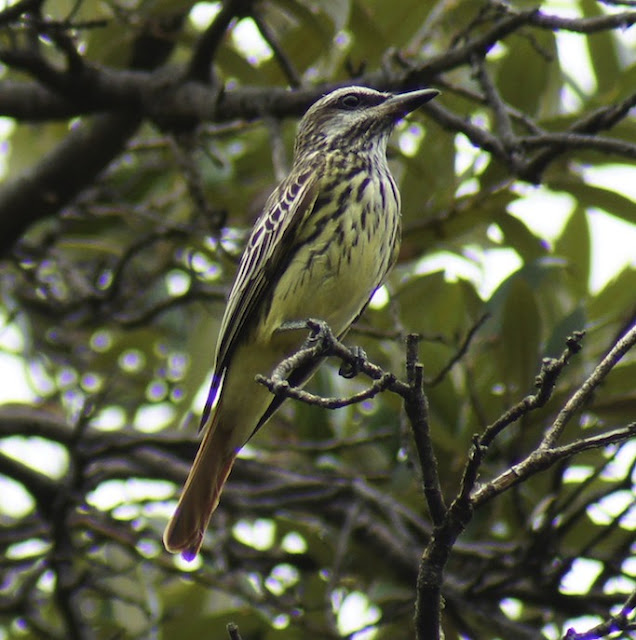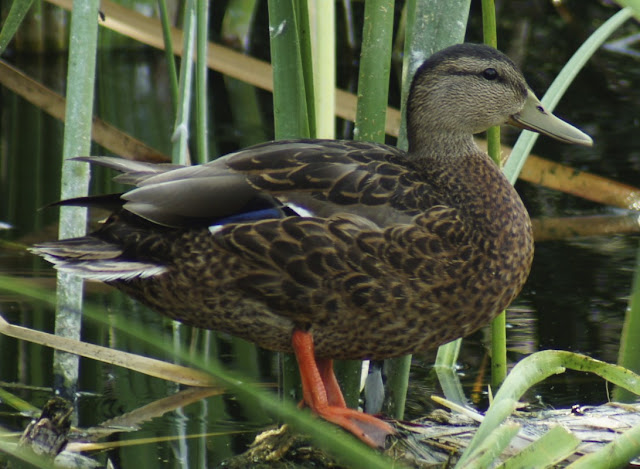Last week Pops and I embarked on a birding excursion to southeast Arizona that had the potential to be marvelous, with a chance of becoming epic, and that ended up being legendary for Butler birding. With only half a day at our disposal in the Santa Rita Mountains, we had to hit the ground running. We planned to check out the Montosa Canyon on the southwest side of the mountains first, and then explore the Kent Springs trail before moving to the upper Madera sites. It was a complicated itinerary with little room for error--clearly a two-man job.
We reached Montosa Canyon by 6 am, optimistic that we might find a lingering Plain-capped Starthroat seen visiting a feeder near the canyon wash. The Plain-capped Starthroat is not as excitingly colored as the name implies, but it is one of the rarer Hummingbirds to stray into Arizona.
We drove a ways into the canyon seeking out this oddly placed but well-attended feeder. It was moved from its original location, and so Pops and I had to do some splorin' (isn't life hard sometimes?). Before we found the feeder, we were treated to some excellent views of Broad-billed Hummingbirds, Canyon Wrens, and Cardinals. We were also pleasantly surprised to see Varied Buntings off and on throughout the morning, though only the drab females stopped for a picture.
The songs of various rufousy desert Sparrows echoed in the morning air, interrupted by the occasional outburst of Mexican Jays. Although the canyon was very birdy, we did not locate the feeder by 7 am, and I began to get antsy. We needed to see the Starthroat and get up to Madera before it got too late in the day, or so went my worrying. To add to my anxiety, this little female Black-chinned Hummingbird landed nearby and tempted me to turn her into a female Lucifer. Nice try Black-chinned, but you're too big and gray-cheeked! Plus the throat's wrong. Really I don't know what she was playing at...
The hummingbirds weren't the only little birds playing mind tricks. With its more gradual inclines and thick scrub, Montosa Canyon is one of the most reliable areas in the U.S. to see Black-capped Gnatcatchers. Pops and I spent a fair amount of time, really at all of our stops, trying to turn Blue-grays into Black-capped. The best way to ID a Black-capped, especially a silent female, is by the underside of the tail, but even there they look very similar to female Blue-grays. I am afraid the Black-capped Gnatcatcher still eludes me.
Apart from the no-show Gnatcatchers, the day was a great triumph. Pops, who is far more patient than I, found the feeder farther east of our original area, but by that time some other birders and beaten us to the good spots. After about fifteen minutes of waiting and a few twitches brought on by other Hummingbirds, the Starthroat finally made an appearance. It stayed only for a moment and as far as I'm aware did not reappear that day. While hovering near the feeder, Pops and I had great views of the bird's white back, and this blurry photo helped us note of the the proper facial markings. Oddly enough, the other birders in our little cul-de-sac convinced each other that they had, in fact, only seen a Broad-tailed Hummingbird. I don't really see Broad-tailed at all in this bird, and I'm not one to make declarations too soon. I guess some folks are just hard to please. Truth be told I was ready to leave Montosa before Pops found the feeder. I'm very glad that we stuck it out and the virtue of patience was once more reinforced for me.
From Montosa we drove north again, up Madera Canyon road to the Bog Springs campsite. From Bog Springs we took the steep rocky trail towards Kent Springs, hopeful of a few more new birds, some of which were common to the area and others not so much. Sulphur-bellied Flycatchers were one of my 'must-see' birds this summer, and they did not disappoint. The first half of our ascent was fairly quiet and fairly hot. While we did get some great looks at a family of Arizona Woodpeckers in the scrub oak, the initial trek was on the unenjoyable side of arduous. But as we approached the Kent Spring intersection we were ambushed!
The Flycatchers flew back and forth across the trail, shrieking their battle cries with great temerity and daring us to fight them for their territory. We were lucky they did not unleash any face-curdling, sulphur-tinted belches (from which these birds obviously get their name), because they're pretty face-meltingly beautiful already. Arizona's version of the Great Kiskadee, these magnificent flycatchers shown brightly even in overcast weather.
Though the Flycatchers were a definite highlight, they were not the primary objective of our Kent Springs excursion. This semi-obscured House Wren wasn't the primary objective either; it's just cute.
No, the main attraction of Kent Springs this summer is a half-mad half-insane Scarlet Tanager that has been living near the Kent Springs/Bog Springs intersection since the end of May. It had been my hope to see my first Scarlet Tanager this year, presumably when visiting family in Pennsylvania this past June. I did not expect that my first Scarlet Tanager would be in southeast Arizona in July, about 1,200 miles west of its normal range.
Lunatic birds are some of my favorite birds, and the Scarlet Tanager was no exception. As one might expect, this canopy dweller was a real lame-o about getting his picture taken, but the sensory overload when that Scarlet caught some sunlight...it's seared in my brain forever. Every summer Madera Canyon pulls in specialty Hummingbirds, Flycatchers, and Elegant Trogons, but a Scarlet Tanager too? Truly this must be one of the best birding sites on the surface of the sun (Arizona).
The birds received most of our attention, but they were not the only attraction. With its different elevations and ecosystems, Madera Canyon is also a herpetological powerhouse. This Yarrow's Spiny Lizard served as a reminder that superb coloration isn't just the domain of birds and butterflies. If only the birds had this guy's mellow attitude.
Kent Springs wasn't the last stop of the day. Pops and I still had a score to settle with the Elegant Trogons of upper Madera. We backtracked to our vehicle and drove further up the canyon towards the Super Trail (a fitting name for an epic showdown eh?). The stage was set for a great reckoning, like the kind of reckoning that must be immortalized in a special-effects laden, over-the-top Michael Bay movie, but more on that later.



















































